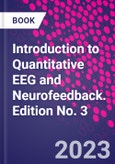Introduction to Quantitative EEG and Neurofeedback, Third Edition offers a window into brain physiology and function via computer and statistical analyses, suggesting innovative approaches to the improvement of attention, anxiety, mood and behavior. Resources for understanding what QEEG and neurofeedback are, how they are used, and to what disorders and patients they can be applied are scarce, hence this volume serves as an ideal tool for clinical researchers and practicing clinicians. Sections cover advancements (including Microcurrent Electrical Stimulation, photobiomodulation), new applications (e.g. Asperger's, music therapy, LORETA, etc.), and combinations of prior approaches.
New chapters on smart-phone technologies and mindfulness highlight their clinical relevance. Written by top scholars in the field, this book offers both the breadth needed for an introductory scholar and the depth desired by a clinical professional.
Please Note: This is an On Demand product, delivery may take up to 11 working days after payment has been received.
Table of Contents
Section I. Raw EEG and QEEG and NFB Foundational Concepts
1. Electroencephalography microstates in relation to emotional decision-making
2. Quantitative�electroencephalography clinical applications: A review and update
3. Electroencephalography imaging and biofeedback training using Z-Scores: databases and LORETA-based methods
4. Autonomic nervous system and the triple network: An evolutionary perspective with clinical implications
5. Taking a deeper look into the wiring of baby humans
6. When can you trust your beta: Detecting electromyography contamination of the electroencephalogram signal to enhance assessment of quantitative electroencephalogram�and electroencephalogram training
7. Origins of electroencephalogram rhythms and implications for neurofeedback
8. History of the scientific standards of quantitative electroencephalography normative databases
9. Electroencephalogram neuroimaging, brain networks and neurofeedback protocols
10. Electroencephalogram in depth: Seeing psyche in brainwaves
11. Theories of brain functioning and the quantitative electroencephalography
Section II. Clinical Applications of NFB
12. Multiple channel advanced standardized weighted low-resolution electromagnetic tomography�training for sustained clinical outcome
13. Utilizing quantitative electroencephalographic�Assessment and standardized low-resolution brain electromagnetic tomography neurotherapy in the treatment of trauma and dissociation
14. Neurofeedback and developmental trauma: Theory and practice�
15. Advances in analysis and training
16. The importance of contingency between electroencephalographic patterns and neurofeedback for sustained clinical outcome
17. Endogenous neuromodulation at infra-low frequencies
18. Neurofeedback in elite and athlete performance
19. Application of electroencephalogram and other neurophysiological measures in assessment of cue-reactivity in individuals with substance use disorder
20. Quantitative electroencephalogram, event-related potential and neurofeedback in substance use disorders research and treatment
21. Asperger's syndrome intervention: Combining neurofeedback, biofeedback and metacognition
22.�Effective intervention�for�attention-deficit/hyperactivity disorders using quantitative electroencephalography and neurofeedback��������������������������������������������������������������������������������������������������������������������������������������������� 23. Alpha-theta neurotherapy and the neurobehavioral treatment of addictions, mood disorders, and trauma
Section III. Complementary Approaches and Adjunctive Concepts for Neuromodulation and NFB
24. Midstream exchange between the gastrointestinal system and the brain
25. pIR HEG neurofeedback and nIR HEG neurofeedback, best practices
26. "Wearables�: �A new age of personal empowerment
27. Optimal biofeedback:� Combining neurofeedback and integrative neuromodulation through light, sound, vestibular/cerebellar stimulation and heart rate variability
28. Music and neuromodulation
29. Physiology of audio-visual entrainment technology
30. Lifestyle and environmental influences on electroencephalography, quantitative electroencephalography, and Neurofeedback
Section IV. Ethical and Legal Issues
31. Quantitative electroencephalography�goes to court
Applications in liability and capital cases
32. Ethical principles in neurofeedback standards of care and clinical practice








